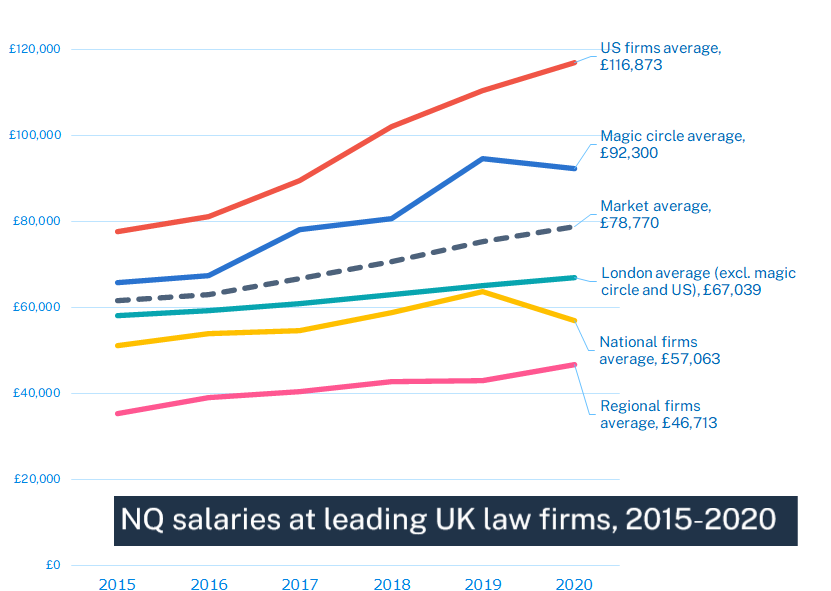
Show me the money – specifically in correlation with trainee job satisfaction metrics. Here we examine the last five years of law firm salary movements and compare the salaries to trainee experiences.
9 March 2021 | Antony Cooke
Ignore your friends at law school. Ignore your parents. Ignore woolly terms like ‘prestige’ and ‘status’. On your approach into the law you’ll face an unending stream of rumour, social pressure and marketing, all contriving to taint your good judgement. But with your sharp, lawyerly mind, you’ll naturally view all of this with scepticism: instead of being swayed by law firm marketing, you’ll choose firms methodically, knowing what’s good for you.
And above all you’ll remember that a better word for ‘salary’ is ‘compensation’, because everything in business involves a certain trade-off. Everything has a value. Here we look at what those trade-offs might be, and how those salaries tell a story about the law firm.
Top read: Law firm salaries compared
We have to be realistic and acknowledge that the promise of a high salary is always lurking at some point in the student’s decision to pursue the law. And if that’s your primary motivation, you’re not alone, but our research both in the UK and the US finds that successful candidates’ primary motivation is the intellectual challenge of the law – remember that when you’re choosing practice areas and firms.
Lawyer salaries are part of a bigger picture of an inflexible economy; one that relies on lawyers taking ownership of their cases and building a client portfolio all the way up to partnership. It leaves little wiggle-room for quality of life, especially during crucial moments like raising a family. Last month we observed what this meant for women, in particular.
Nevertheless, it is fascinating to gawp at the figures these firms offer. Here we have charted law firm salaries since 2015.
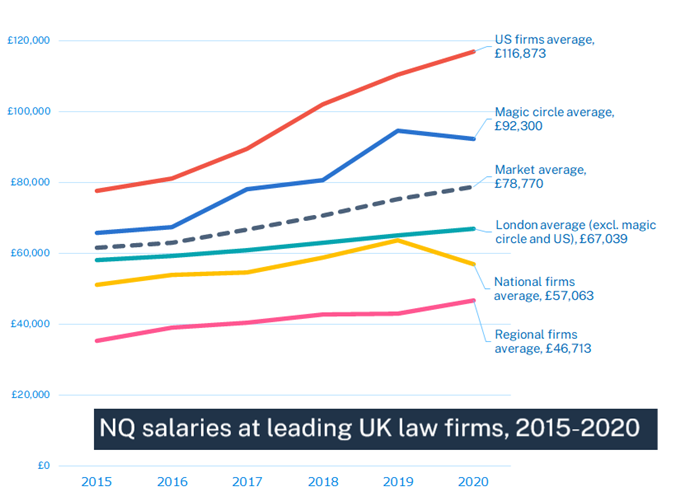
The US firms always steal the show on salaries – that’s their aim. These firms have roughly the same degree of clout globally as the magic circle, but the US firms have always paid above the odds in London. Their salaries send a message that they should be taken seriously, and that they’re competing for the same talent pool as the magic circle, whose stronger brands in the UK mean these five can afford to chill a little on the salary hikes.
23 years ago when we first started research, Cleary Gottlieb and White & Case were making a big splash on the London scene with NQ salaries at 40-50% above the magic circle. These two firms were some of the first big US names to enter the London market. But now they’ve established themselves and got their slew of Chambers rankings, they can afford to relax and let their brand carry them. Now is the time for Kirkland, Vinson & Elkins, Akin Gump and Latham to make their mark, paying the US BigLaw first-year equivalent of $190,000. Imitating what we saw from the 1998 London rookies Cleary and White & Case, these firms are also paying at 40-50% above the London elite.
‘The prevailing message is that law firms have not suffered in the way other industries have.’
The data here shows 2017-18 as the year the US firms chose to up the ante, sparking a phase of salary inflation in London and causing the magic circle to play ball to some degree – as ever choosing the middle ground between the City firms and the US. There are three factors going on here: the first is the Brexit referendum and the devaluation of the pound, leaving firms with US HQs to take advantage; the second is the salary war that started in New York in summer 2016 (market rate went from $160,000 to $180,000, then up again in 2019 to $190,000); and the third is the sustained growth of the private equity market – something of a specialist area for many US firms.
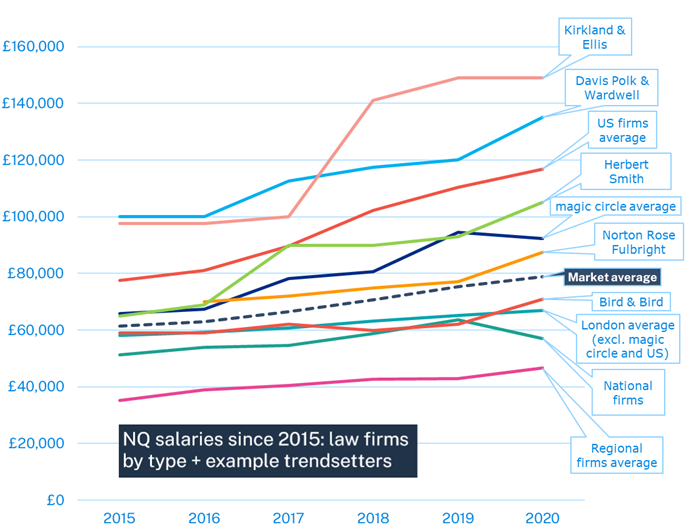
Considering the recession we’ve lived through in 2020, it may be a surprise to see the NQ salaries continue exactly the same steady rate of increase. But the lesson we took from our US research this year was that lawyers are resilient, finding opportunity in disorder. The prevailing message is that law firms have not suffered in the way other industries have. The data above shows some groups of firms reducing their NQ salaries in the face of a pandemic, but this was more of a precautionary measure: the national firms and the magic circle have the biggest salary liabilities in the UK; this temporary dip is probably a smart move.
This year has created the opportunity for a few London firms to reposition themselves in the market. Herbert Smith Freehills – if there were ever a sixth magic circler it would be Herbies – have for a few years been aligning themselves with the global elite rather than the London crowd. We singled out Norton Rose Fulbright in the graph because they typify a few firms at the upper end of the City who chose to hold tight on their 2020 salary increase, rather than following most of the magic circle in making reductions, so the gap between these two groups narrowed.
Bird & Bird represents a handful of tech-focused firms who have stuck with their salary rise this year. If you consider how we’ve all managed to survive and work in 2020/21, it makes perfect sense to see techy firms feeling confident. In the US we’ve seen the industry shifting associates away from corporate and finance and sending them to technology more than any other practice area, even restructuring and insolvency.
So when you look at a salary figure, banish those dollar signs from your eyeballs and think only this: a salary is a marketing tool; a salary tells us economic context; a salary is a trade-off as much as it is a reward. We look at a few of those trade-offs.
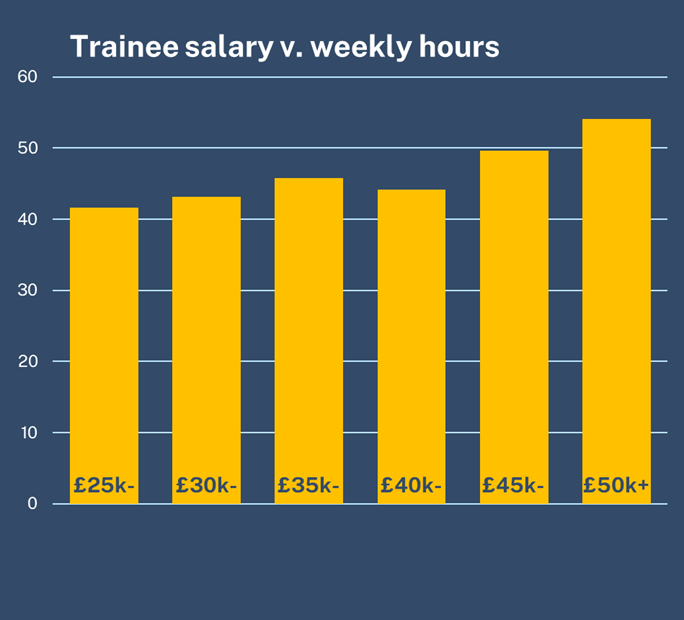
The most obvious place to start is hours. We asked trainees to estimate the hours they worked in their last full working week. Here we give the average by salary group. In a lot of our research, a happy medium emerges at the £40k mark.
Imagine for one minute that trainees are doing a temp job contracted by the hour: how much is each hour of work worth to the trainee? We see the benefit of the higher salary start to tail off at £40k.
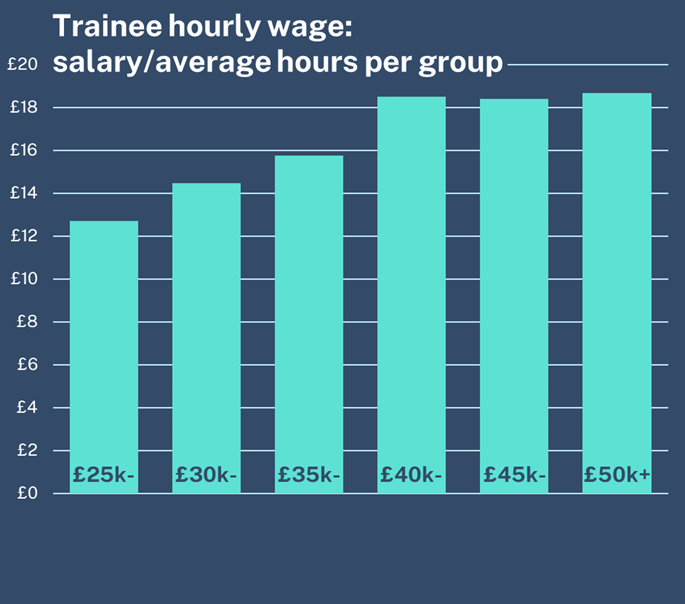
Here trainees tell us about the impact of their work on their mental health, which needs little explanation, except that we used the same scale to measure all trainee opinions.
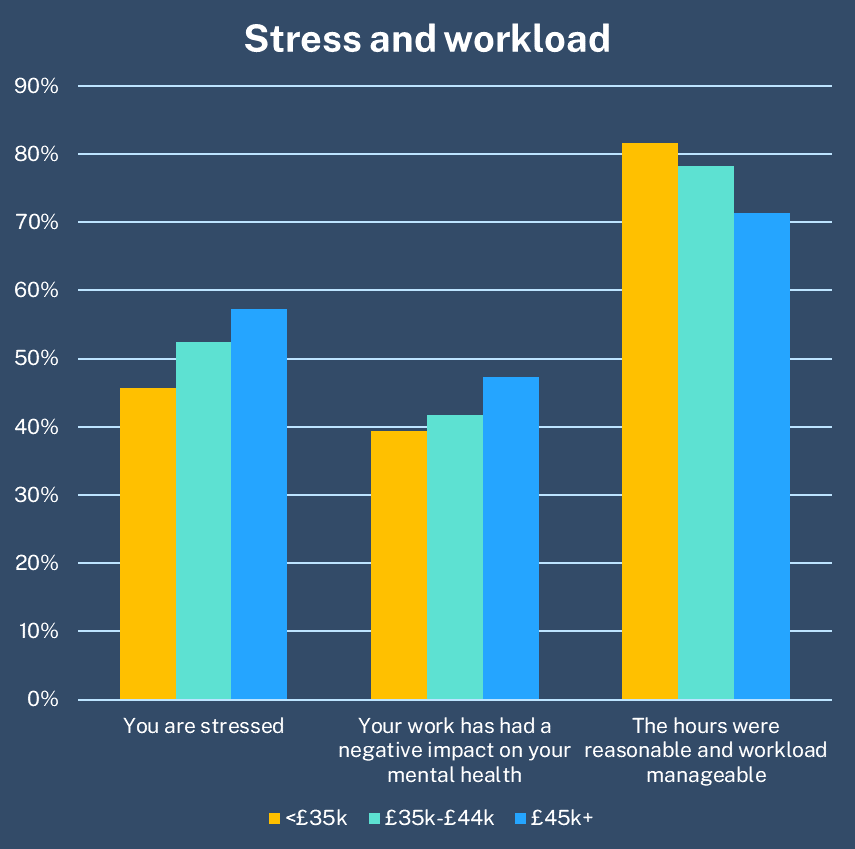
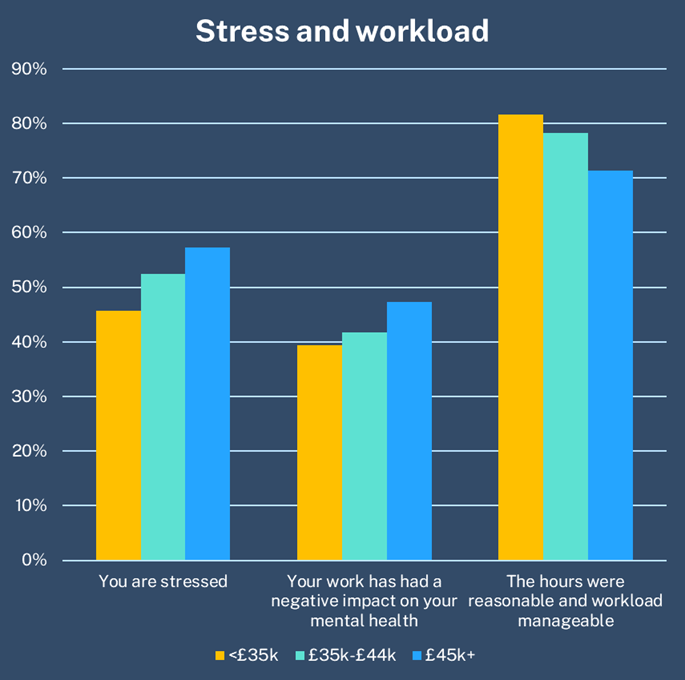
Understanding what you’re entering into is important in this demanding profession. By presenting this data we’re not quite warning against applying to the high-paying firms for the sake of your mental health. The legal profession is the natural habitat of complex, high achievers. So many students who join the law are unable to conceive of a life that isn’t challenging and competitive, and they are fully aware of what the trade-off is. So our advice is to go in with the best information. Incidentally, in the True Picture we review each law firm on their trainees’ mental wellbeing.
Another trope about the law is that the bigger the firm, the more formal the hierarchy is. There are practical reasons for this: deals are giant, often cross-border, and the trainee will often work on a discrete element of that broader global deal for a limited time period. The client may not even be in the same time zone.
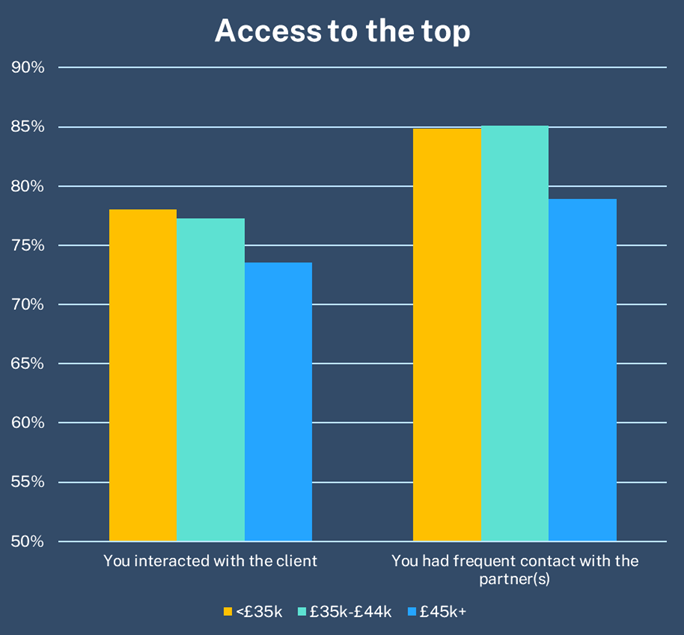
This dynamic might imply that those crucial moments in career development are scarcer at higher-paying firms. It is true that the higher the salary, the harder it is to make partner. But we should remember that many of these firms – the magic circle in particular – are famous for the quality of their training. They will make your career whether you stay to partnership or not. In fact, looking beyond client and partner contact, we found no correlation between salary bracket and trainees’ satisfaction with their overall career development.
If we return to the idea of salaries being a trade-off but instead take the view that economics will find a natural balance, we found a certain affirmation of this among trainees. Across the six broad topics of our research – general satisfaction, the seats, career development, diversity and inclusion, retention, working cultures – we found no strong correlations between any of these measures of satisfaction and trainee salary. The graph below for general satisfaction shows the £40k group pulling away slightly, but we wouldn’t call it significant.
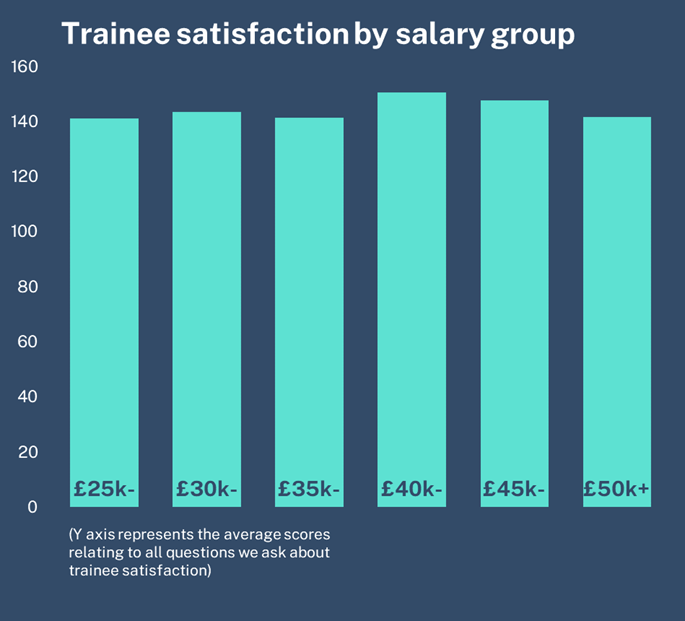
We’ve looked at what trainees are expected to give for their salary, but the narrative doesn’t always conform to this crude cliché. The higher performing firms are impressive places in so many respects. The talent they surround you with, the calibre of cases they expose you to, the international learning experience they offer, the sheer scale of the support resources, the breadth of career opportunities – the elite firms are the natural destination for elite students.
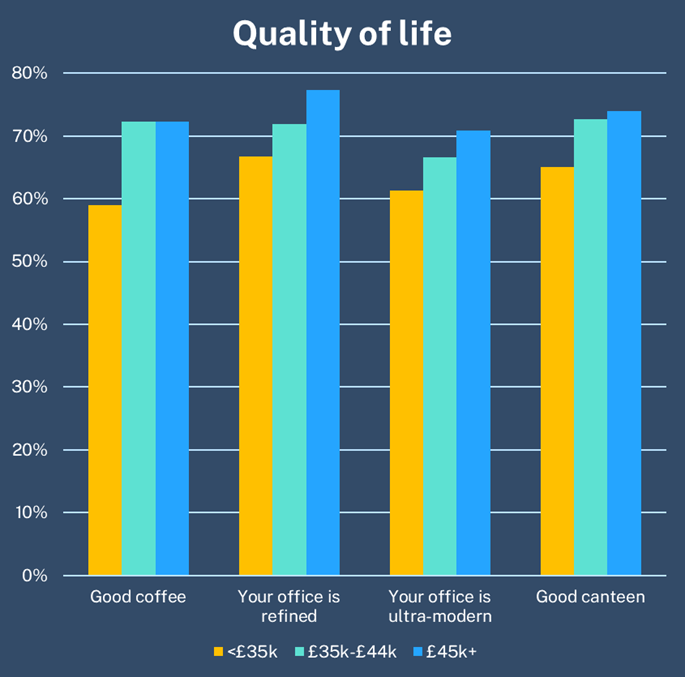
For everything we’ve said about the demands of elite firms, there’s a satisfying symmetry in the hardest-working students being rewarded for it when they enter employment. The salary is part of the picture, but we also found these firms making a more compelling case to trainees to keep them on for the long-haul.
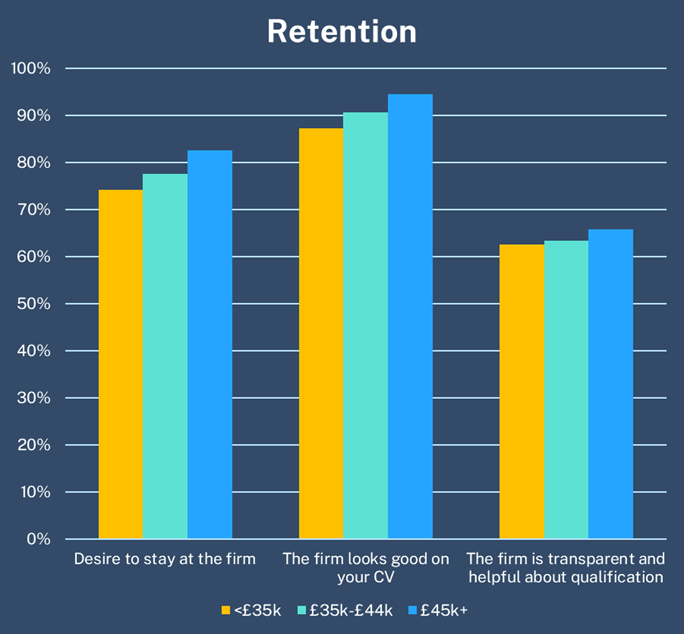
Another cliché to challenge is corporate firms’ single-minded focus on billing. These firms are well resourced to develop a trainee’s pro bono experience, and the US firms are market leaders in this. In the States pro bono is a more institutionalised part of law firm life, whereas in the UK, we have historically fallen back on legal aid rather than pro bono. Given the huge erosion of legal aid budgets since 2012, we might see pro bono come to the fore at law firms.
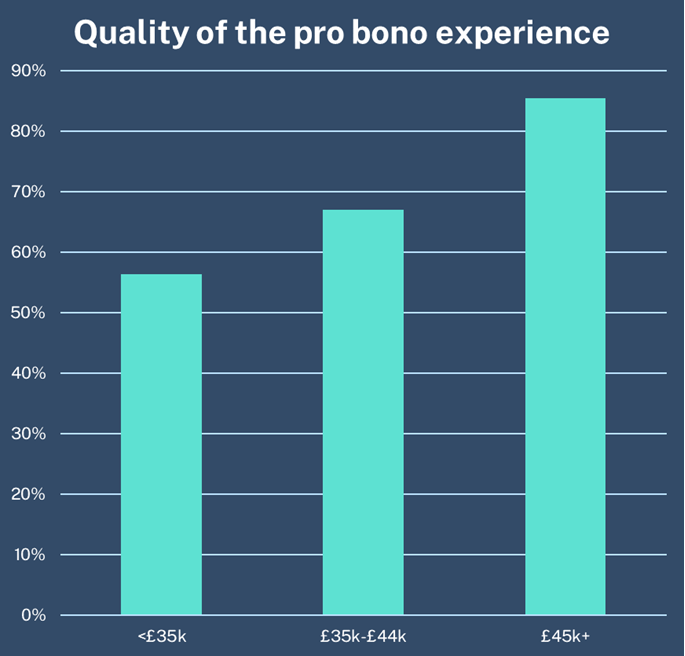
A lot of the discussion here implies there’s a formula to law firm life: what you take with one hand you give with the other. But there is as much complexity as there is conformity. Every law firm does its own thing, as you’ll learn from reading the True Picture. Every law firm offers its own unique developmental experience. Just make sure that the last thing you consider in choosing a firm is its salary.
How the NQ salary pool is shared between women and men.
How your school background affects your eventual earnings.
Further reading: Law firm salaries compared | Are lawyers being paid too much? | How much do Barristers earn? | Are lawyers' high salaries justified? | Lawyer salaries in the US market